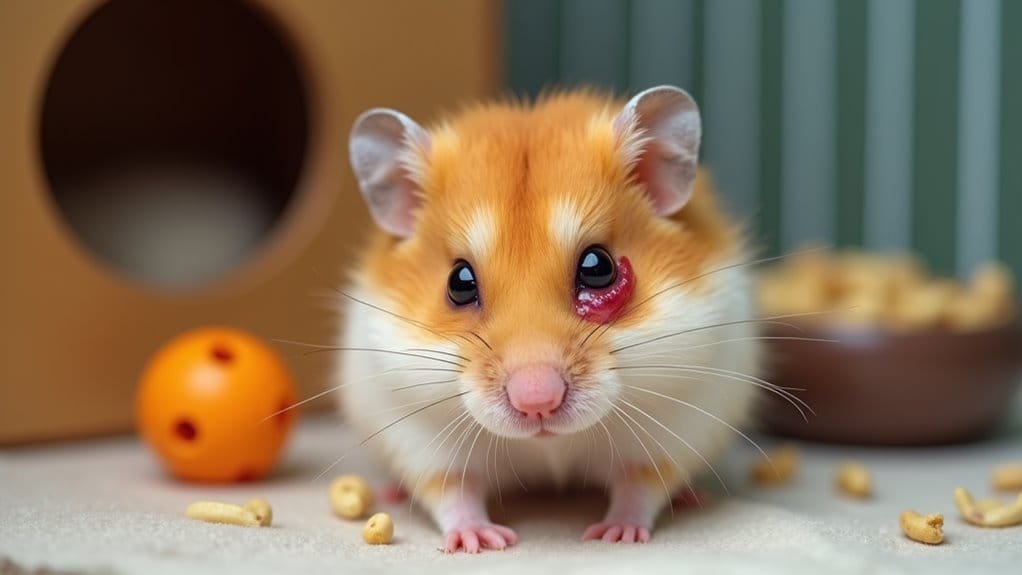Hamster eye infections can be a real hassle, can’t they? They often happen due to things like poor hygiene, dusty bedding, or even dental issues. Keep an eye out for red, swollen eyes or crustiness—these are signs something’s up. Doctors can help with treatments like antibiotics and eye drops, but prevention is key! Clean cages and good bedding can make a world of difference. Think of it as making a cozy apartment for your little buddy. If you want to know how to spot issues sooner or keep those peepers healthy, just hang tight!
Causes of Eye Infections
Eye infections in hamsters can arise from various causes, so it’s essential to be aware of the factors that contribute to these issues.
First off, did you know that dental problems, like malocclusion, can actually mess with your hamster’s eyes? It’s true! When their teeth don’t align properly, it can put pressure on tear ducts, leading to infections. Not fun, right?
Then there’s the environment. If you’re using dusty bedding, your little buddy’s eyes might get irritated. Think about sneezing when you walk into a dusty room—yikes! Maintaining a clean and sanitized cage environment can help prevent irritation from bedding materials.
Plus, poor hygiene in their cage can lead to all sorts of nastiness.
Oh, and let’s not forget about nasty germs. Bacteria, viruses, and even fungi can sneak in and cause eye infections. It’s like an unwanted party your hamster didn’t invite!
And don’t overlook trauma. Just like us, hamsters can get hurt. A bite or a bump can lead to eye issues.
Symptoms to Watch For
When it comes to spotting eye infections in hamsters, being observant is key. You might notice your furry friend’s eyes looking a bit red or swollen—uh-oh! That’s a sign something’s not right.
Keep an eye out for discharge or crustiness around their eyes, too. If you see your hamster squinting or having trouble maneuvering their eyes open, it’s time to pay attention.
Watch for changes in their behavior, like pawing at their face or blinking a lot. Are they having trouble traversing their cage? That’s a big red flag! Eye infections can also cause excessive tearing, which may further indicate discomfort.
If they seem extra sensitive to light or aren’t eating well, they might be struggling with their sight.
Don’t ignore any serious signs, either. If you notice bulging eyes, blood in the discharge, or severe swelling, please take action immediately! Those symptoms are like a hamster SOS.
Changes in eye color or complete eye closure are also big indicators that your pet needs help. So, if your little buddy isn’t acting quite like themselves, trust your gut and get them checked out. You want them to be the happy, playful hamster you know and love!
Types of Eye Problems
Noticing symptoms in your hamster is just the first step; understanding the types of eye problems they might face is equally important.
Hamsters can get into all sorts of trouble, and their eyes can suffer too! Here are some common eye issues you should look out for:
- Conjunctivitis: This is when the eye gets red and might’ve some gooey stuff oozing out.
- Corneal Ulcers: Think of this as a scratch on their eye; it can hurt and lead to infections.
- Exophthalmia: That’s when the eye bulges out, which can look pretty alarming! Eye bulging is common in hamsters due to their shallow eye sockets and can indicate an underlying condition.
- Proptosis: This is when the eye pops out of its socket, usually due to a mishap or rough handling.
- Glaucoma: This one’s sneaky; it raises pressure in the eye, causing pain and potential vision loss.
Keeping an eye on these issues helps you catch problems early.
So, if you notice any of these signs, don’t wait around! Your little buddy deserves the best care, and being informed is half the battle.
After all, a happy hamster means a happy you!
Diagnosis Methods
Diagnosing eye infections in hamsters involves a thorough evaluation by a veterinarian, who’ll use various methods to determine the specific issue.
First off, they’ll give your little furball a physical exam. If your hamster’s squinting or has a swollen eye, that’s a big red flag! Swelling can mean infection or even trauma. And if you see any funky discharge—like creamy or yellow stuff—it’s time to take action.
Then, the vet might do some cool tests. A corneal stain checks for scratches on the eye, while a pressure check can reveal glaucoma. Sounds fancy, right? They might even check tear production with a simple test, like measuring how much moisture your hamster’s eyes produce. If your little buddy’s blinking like crazy, that could mean irritation. Additionally, veterinary care should be sought within 24 hours of symptom onset to ensure prompt treatment.
Sometimes, special tools are used to look deeper. Maybe they’ll need to use sedation for the exam, especially if your hamster’s a squirmy one.
Treatment and Prevention
Once a vet confirms your hamster has an eye infection, it’s time to explore treatment and prevention strategies. You wanna keep your little buddy comfortable and healthy, right?
Here’s what you can do:
- Prescription Antibiotics: Your vet might give you some oral antibiotics to tackle that pesky infection.
- Eye Drops: They may also suggest topical antibiotics. Just a little drop right on the eye can work wonders!
- Pain Management: If your hamster’s feeling sore, pain meds can help ease that discomfort.
- Eye Cleaning: Keeping those peepers clean is a must! Use sterile saline or clean wipes to get rid of any gunk.
- Vet Intervention: Sometimes, a vet’s help is necessary for serious cases.
Prevention is key, too! Clean your hamster’s cage regularly, pick the right bedding, and keep an eye on those eyes!
Don’t forget to check in with the vet for routine check-ups.




